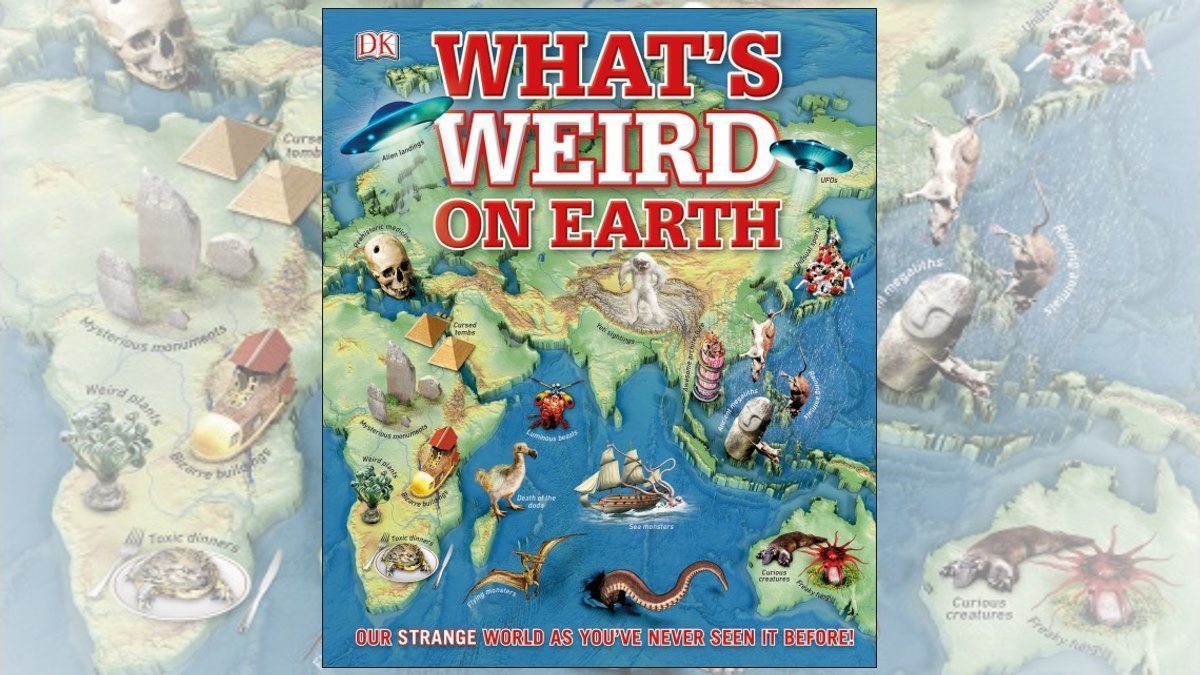 This week’s word is “Weird.”
This week’s word is “Weird.”
As well as liking the periodic table, I do love a map. And, if there’s one thing I like more than a map, it’s a map that displays esoteric data. Not for the first time, DK books has supplied me with a book I didn’t know I needed. What’s Weird on Earth is a book of maps of the world, with each map covered in facts you didn’t know you didn’t know. More than that, they’re facts that you didn’t know that you REALLY wanted to know.
If you want to know where the world’s deadliest food treats are, where all the best mazes are, or where to see a building in the shape of a grand piano, this is the book for you. Like all DK books, it’s bright, engaging, and great fun to flick through. What’s Weird on Earth is looking to immerse children aged 8+ in peculiar geographica.
What is What’s Weird on Earth?
It’s an atlas with a difference. This book won’t tell you the capital of Poland, the length of the Mississippi, nor the height of Mount Kilimanjaro, but it will tell you which nation has the most children, what would happen if the all the ice caps melted, and where Google’s data center is. You can also find out more about orange snow, where it’s rained frogs and where you might find the Latticed Stinkhorn. It’s that sort of book. (Note: The book will, in fact, tell you the capital of Poland. The inside front cover has a political map of the world. The rear of the book has a physical map. No river lengths though.)
What’s Weird on Earth’s sections?
- Nature: This section includes strange weather, where lightning strikes the most often, and peculiar trees of the world.
- Supernatural: UFO sightings, curses, and peculiar mistakes are found in this section. (Mistakes like Orson Welles’ Martian invasion causing widespread panic.) There is no indication as to where all our odd socks go, which is disappointing.
- Places: Eternal flames, no-go zones, and holiday hotspots are all here. As is a great page on crazy bridges. The Places section has two of my favorite double-page spreads. One features how the Earth looked 270 million years ago. Always interesting, but this version of Pangea has a political map superimposed on it. Next, there is a map of how the Earth may look in another 100 million years. Spoiler Alert: Flights to Australia from London will be several hours shorter.
- People: The People section has some great world maps that are adjusted for the size of a particular statistic. See Asia swollen by its number of children or a super-massive Europe, distorted to allow for numbers of tourists. There’s also a colorful map, featuring “far-out” festivals, and a map of the world’s most dangerous roads. (Could also double as a Grand Tour episode list.)
- History: In the History section we have mega megaliths and peculiar wars (such as 1325’s War of the Oaken Bucket).
- Fun Facts: The Fun Facts section may well be my favorite of the book. This is a continent by continent look at peculiar facts, all presented using the power of the infographic. So whether you want to know which country has the most churches per square mile, how long it takes to boil an egg at the Binh Chu hot springs, or that Scotland’s national animal is the unicorn, this is the section for you. One fun fact is possibly the best piece of information I’ve ever learned – a traditional Tibetan way of measuring distance was by how many cups of tea were needed for the journey.

Why read What’s Weird on Earth?
Like many DK books, What’s Weird on Earth is an engaging book for children. By using the weird and downright strange, the book taps into the imaginations of its readers, inspiring them to learn geography, history, and a bit of natural history too.
If I have a criticism of the book it would lie with the “Supernatural” section. Some of the information presented, like the hilarious hoaxes or even places in the world that are considered lucky, is fine, but I’m less happy with the pages about alien sightings and haunted houses. For me, not enough is done to suggest that these are myths. If I was a credulous child, I might conceive that UFOs really have been spotted or that ghosts of dead Presidents actually wander the halls of the White House. Considering the amount of good quality information in the rest of the book, this seems like an oversight and more should have been done to debunk these legends.
Other than this supernatural peeve, I think this is a great book. It reminds me of Lonely Planet’s Not for Parents Travel Book, a firm favorite in our house. Anything that can inspire investigation and interest in the world’s flora, fauna, architecture, or customs can only be a good thing. What’s Weird on Earth is the perfect gift for that child that you have no idea what to buy them. They’re unlikely to have something like it already, and they’re bound to find something of interest within its pages.
You can buy What’s Weird on Earth, here in the US, and here, in the UK.
If you enjoyed this post, don’t forget to check out my other Word Wednesday posts, here.
Disclaimer: I was sent a copy of this book in order to write this review.




